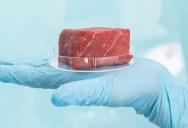Food Scientists Plan To Make Fake Meat Tastier By Including Pig Genes
by Trisha Leigh

While I was reading through some research for this article, I couldn’t help but wonder how the vegan community will feel about it.
I mean, even if pig genes could help improve the taste of soy burgers and the like, would they be morally opposed? Maybe it has to do with how those genes are obtained?
But while all of these questions might not have answers yet, the planned process if definitely interesting enough to share.
This “Piggy Sooy” comes from a company called Moolec. The transgenic soya beans are a quarter pig protein and three-quarters plant protein.
The same company is working on pea plants that contain beef proteins, and claims these products will have a similar taste, texture, and nutritional value to traditional meat.

That said, they’re playing the details – like what pig genes are included – close to the vest.
“At this point we can’t disclose that, for intellectual property reasons.”
These “Piggy Sooy” beans appear to have a pinky-red tinge inside of them, though, so experts think the genes could come from an iron-containing haem genetic group (myoglobin) – these give red meat it’s color and some of its flavor.
Impossible Foods does something similar in adding a plant haem protein called soy leghaemoglobin, which gives their product a more meat-like look and taste.
Motif, another food company, produces beef myoglobin as an additive called Hemani. It is also used in meat substitutes.
Products like these, and Piggy Sooy, could help make non-meat-based foods more palatable, and therefore help our food supply become more sustainable.

That said, environmental writer Mark Lynas says we’ll have to wait to see how the public reacts to the creation and taste/texture of this and other genetically modified products.
“I really have no idea how this will land. It’s interesting that they have gone all-out for the ‘piggy’ thing – there is no attempt to sweeten the pill. Of course, scientifically it’s just a protein, and we already engineer lots of plants and microbes to make desirable proteins.”
Seren Kell, at the Good Food Institute Europe, believes this is what people are asking for, though.
“While we aren’t aware of research specifically looking at molecular farming, there is strong evidence that consumers want – and are actively seeking out – more sustainable alternatives to animal agriculture. Sales of plant-based options have increased by 21 percent in Europe since 2020.”
Since around 98% of all soya grown in the US is already genetically modified, Moolec (and others) are thinking this won’t be that big of a deal.

They are already in the process of getting approval to grow and sell Piggy Sooy in the United States.
“In the US, food ingredients developed in this manner would be considered under the FDA’s voluntary pre-market consultation programme for foods from new plant varieties.”
The approval process in Europe would likely take closer to 18 months.
We’ll have to just wait and see, I suppose.
Until people start actually eating it, the jury is out on public opinion – on taste and on origin.
If you enjoyed that story, check out what happened when a guy gave ChatGPT $100 to make as money as possible, and it turned out exactly how you would expect.
Categories: ANIMALS, THE REST
Tags: · food, food science, genetics, moolec, piggy sooy, pigs, plant based meat options, plant-based meat, science, single topic, top

Sign up to get our BEST stories of the week straight to your inbox.




